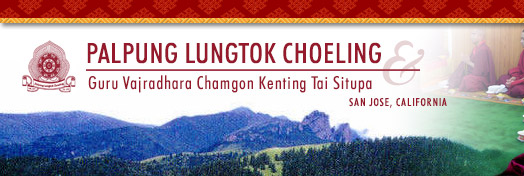
Self-portrait of the 8th Tai Situpa,
the Palpung Founder
|
History
Origins of Vajrayana Buddhism
More than 2600 years ago, Prince Siddhartha attained enlightenment at the holy seat of Bodh Gaya and came to be known as Buddha Sakyamuni.
The Buddha first turned the wheel of Dharma at Samath. He taught what are known as the "Four Noble Truths" and subsequently taught on Boddhichitta, Emptiness, and Transformation Manifest. These teachings were later compiled in the Vinaya, Abhidharma, Sutra, and Tantra, and continue today as Theravada, Mahayana, and Vajrayana Buddhism.
In the 9th century, the great Indian master, Guru Padmasambbava, at the invitation of the King of Tibet, Trisong Detsen, firmly planted the teachings of Buddha in Tibet. The teachings flourished through many unbroken lineages under the transmission of generations of enlightened masters.
In the centuries that followed, four major lineages developed: the Nyingma, Sakya, Kagyu, and the Gelug.
History of the Palpung Monasteries - Kagyur Lineage
In 1757, the 8th Tai Situpa founded the great Palpung Monastery, his main monastic seat in Eastern Tibet. Palpung became the administrative center for over one-hundred eighty monasteries and thirteen monastic estates throughout greater Tibet. Palpung was a great center of learning and one of the most prestigious institutions in Tibetan history, with an extensive library and thousands of treasured paintings and artifacts. The word Palpung literally means "Glorious Accumulation", a place where talented people are cultivated.
By the time of the 11th Tai Situpa, Palpung had a solid reputation for spiritual, scholarly, and artistic excellence and authority. Several important incarnate emanations were in traditional residence in addition to the supreme head of the Palpung Monastery, the Chamgon Tai Situpa himself. Palpung and its branches looked to the Tai Situpa for guidance in all their spiritual and temporal affairs. Following the occupation of Tibet by Communist China in the late 1950's, most of Palpung Monastery was destroyed and the Palpung Seat became dysfunctional.
The Tai Situpa then began Palpung SherabLing Monastery in India, with a vision to create a place to transmit the Tibetan Buddhist tradition in its pure form. He also recognized the growing interest of Buddhism throughout the world and wished to provide the opportunity where people can study and practice Buddhism as a traditional monastic environment.
Begun in the late 1970's on 30 acres of land offered by the followers of the Tai Situpa, Palpung SherabLing Monastery has developed over time into a major seat of the Kagyu Lineage and now houses over 750 monks and nuns. The project encompasses four independent aspects: Spiritual, Educational, Health, and Culture.
About our Guru, Guru Vajradhara Chamgon Kenting Tai Situpa
Guru Vajradhara Chamgon Kenting Tai Situpa is the twelfth in an unbroken line of incarnations, which began in the 11th century. The title Kenting Tai Situ means "far reaching, unshakable, great master, holder of the command."
Read more about our guru.
| |



